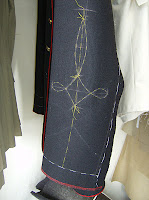Well, it has been a very busy start to a new season of work. I have some nice 1880's Victorian work to do, some 1930's, and some Edwardian as well, so I am looking forward to it!
There has been a lot of concern with the economy as we are a business to a large degree dependent on our patron's disposable income.
We are often asked whether we reuse costumes, and the answer is yes, we do. Most shows use at least some pieces from previous productions and because they are made well, they last, and are able to be refurbished, and reused.
This year, one of the things that are being reused are uniforms that we built in 2008.
We refit some of these already, and found to our shock that someone had removed the trim from the sleeves of one of the uniforms! Arggh! These were not supposed to be rented out so it is a mystery why it was done and for what reason. Luckily we had some of the trim left in stock, and since the sleeves were too long for the actor who is now going to wear it, we can shorten the sleeves and retrim them.
I did spend a frantic few minutes searching through boxes of patterns that I kept, hoping that I kept a copy of the sleeve decoration pattern so I didn't have to rethink and redraw it.
Luck was with me and I did have it stashed away. Whew!
I can't keep everything, so I throw lots of patterns out, and you know, everytime I throw them away, I have that nagging feeling that as soon as they hit the recycling bin, I will need them within the next 24 hours. I don't think I am alone in this feeling.

So, then it turns out that we are going to be making a couple more of these uniforms to add to the collection, so now we are on the hunt for more trim. If the trim had not been removed from these sleeves we might have had enough to trim for the two new uniforms, but not now.
And so it goes.......



